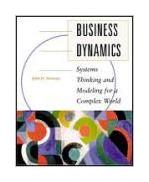Today's leading authority
on the subject of this text is the author, MIT Standish Professor of Management and
Director of the System Dynamics Group, John D. Sterman. Sterman's objective is to
explain, in a true textbook format, what system dynamics is, and how it can be
successfully applied to solve business and organizational problems. System dynamics is
both a currently utilized approach to organizational problem solving at the professional
level, and a field of study in business, engineering, and social and physical sciences.
Incorporates a modeling approach: Modeling and models help students learn to visualize a
business organization through structures and policies that create dynamics and regulate
performance. Students gain a better understanding of how an organization's performance
is related to its internal structure and operating policies-as well as to the operating
policies of its customers, competitors, and suppliers. Offers role-playing experiential
exercises: The book offers diverse modes of learning, including role-playing exercises.
This "active learning" approach engages students, vitalizes the subject matter, and
helps develop students' abilities to "think on their feet." Utilizes case studies
depicting real companies throughout: Case studies of successful design and implementation
strategies are used to illustrate systems dynamics principles. This approach offers both
realism and proof of the effectiveness of system dynamics principles when applied, in a
practical fashion, to real business problems and situations. Emphasizes the use and
construction of simulation models and flight simulation exercises: Simulation models and
flight simulators are used to develop principles of policy design. This permits both the
exploration and the understanding of such complex issues as fluctuating sales, production
and earnings, market growth and stagnation, the diffusion of new technologies, the use and
reliability of forecasts, and the rationality of business decision-making.
Table of Contents
Introduction
Part I. Perspective and Process
1. Learning In and About Complex Systems
2. System Dynamics In Action
3. The Modeling Process
4. Structure and Behavior of Dynamic Systems
Part II. Tools for Systems Thinking
5. Causal Loop Diagrams
6. Stocks and Flows
7. Dynamics of Stocks and Flows
8. Closing the Loop: Dynamics of Simple Structures
Part III. The Dynamics of Growth
9. S-Shaped Growth: Epidemics, Innovation Diffusion, and the Growth of New Products
10. Path Dependence and Positive Feedback
Part IV. Tools for Modeling Dynamic Systems
11. Delays
12. Coflows and Aging Chains
13. Modeling Decision Making
14. Forming Non-linear Relationships
Part V. Instability and Oscillation
15. Modeling Human Behavior: Bounded Rationality or Rational Expectations?
16. Forecasts and Fudge Factors: Modeling Expectation Formation
17. Supply Chains and the Origin of Oscillations
18. Managing Supply Chains in Manufacturing
19. The Labor Supply Chain and the Origin of Business Cycles
20. The Invisible Hand Sometimes Shakes: Commodity Cycles
Part VI. Validation and Model Testing
21. Truth and Beauty
Part VII. Commencement
22. Challenges for the Future
Appendix A: Numerical Integration
Appendix B: Noise
References
Index
890 pages
Księgarnia nie działa. Nie odpowiadamy na pytania i nie realizujemy zamówien. Do odwolania !.


